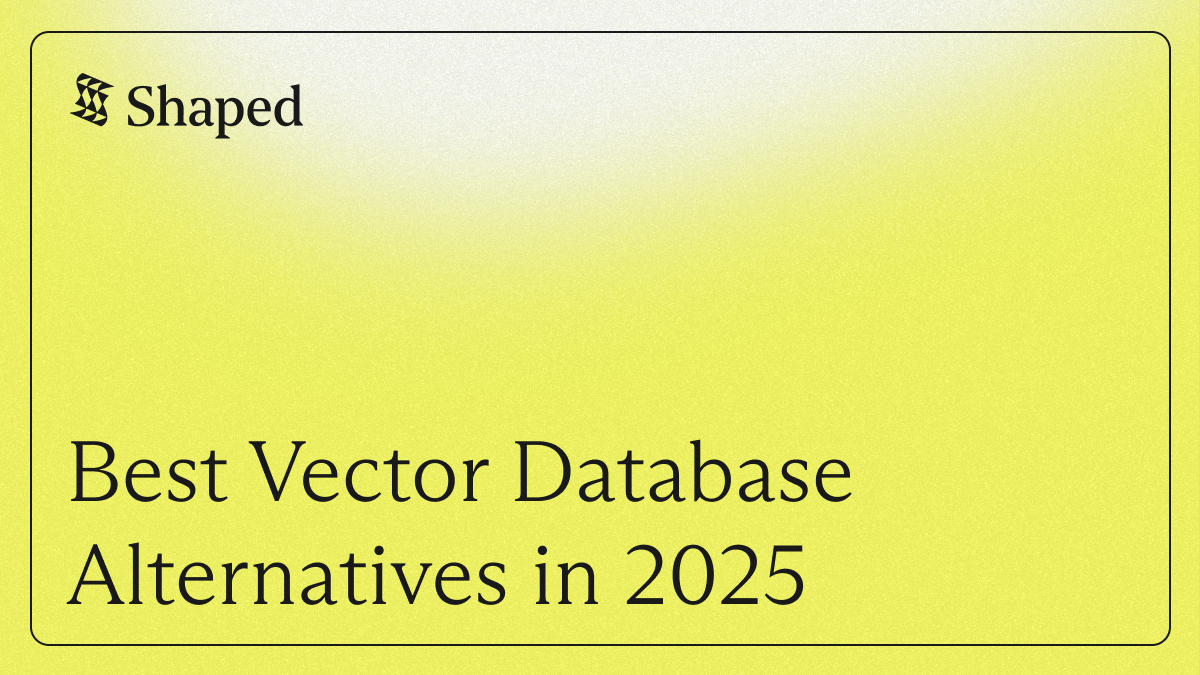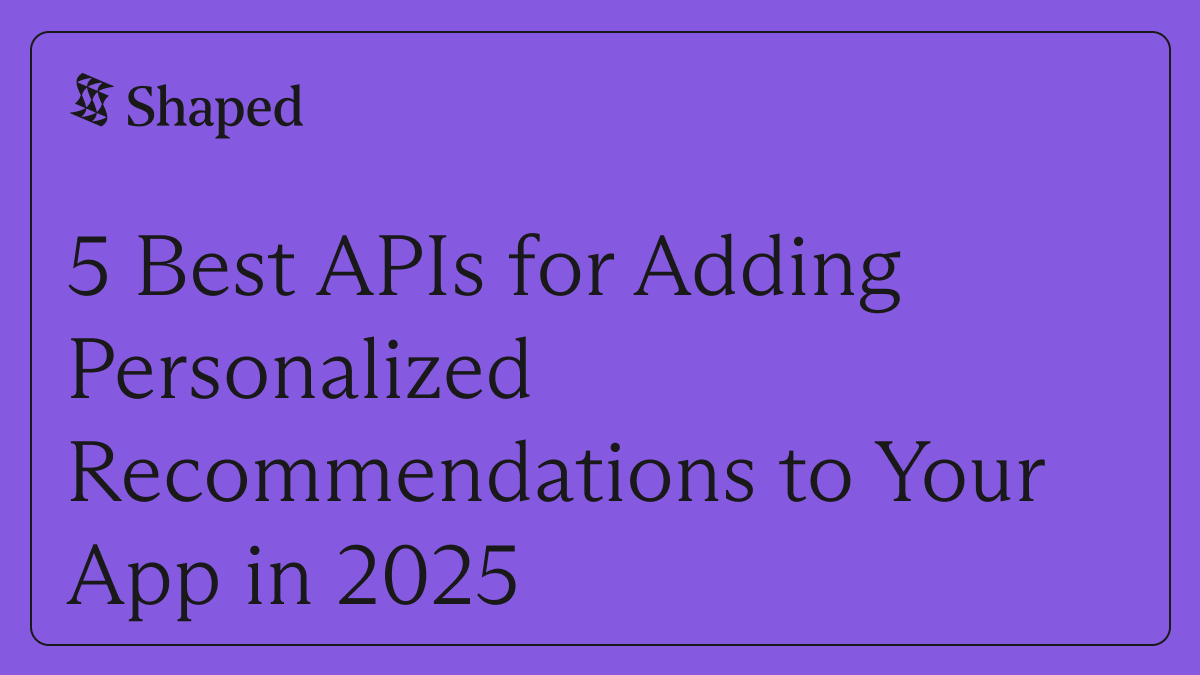By 2025, teams are realizing that DIY with a raw vector DB is costly and complex, requiring ongoing ML, data engineering, and ops resources. That’s why a new wave of vector database alternatives has emerged—platforms that include vector retrieval under the hood but go much further, giving you end-to-end APIs and personalization capabilities out of the box.
1) Shaped — The All-in-One Alternative
Shaped is an AI-native personalization and hybrid search platform that replaces the need to run your own vector DB stack. Instead of wiring Pinecone or Weaviate into a ranking system you maintain, Shaped handles the entire loop:
- Hybrid search: keyword + vector retrieval fused together for relevance (Hybrid Search).
- Ranking & personalization: embeddings, multi-stage ranking (two-tower, ANN, transformers), and real-time session adaptation.
- Value Modeling: blend conversions, engagement, diversity, freshness, and fairness at inference time—without retraining.
- Warehouse-native: plug directly into Snowflake, BigQuery, Redshift, and more with SQL transforms for transparent feature engineering.
- Real-time APIs: personalized feeds, recommendations, and search endpoints ready for production.
Why it’s the #1 alternative: Shaped gives you all the power of a vector DB plus the ranking, experimentation, and business-objective control you’d otherwise have to build yourself. It’s not just storage—it’s intelligence as infrastructure.
2) Algolia AI Search
Algolia started as a keyword search engine but now offers AI-powered search with vector embeddings. For teams already running Algolia, it’s a natural upgrade: you get semantic retrieval, federated indexing, and developer-friendly APIs without managing a separate vector database.
Best for: startups and mid-market teams already invested in Algolia Search who want semantic retrieval as an add-on.
3) Coveo
Coveo focuses on enterprise AI search and discovery. It combines keyword, semantic, and personalized retrieval with analytics, permissions, and governance. While not marketed as a “vector DB,” it abstracts the complexity away and adds enterprise-ready features.
Best for: enterprises with large knowledge bases, commerce catalogs, and strict compliance needs.
4) Bloomreach Discovery
Bloomreach bundles commerce search + recommendations into a single platform. Under the hood it uses embeddings and relevance models, but it presents them as APIs and tools merchandisers can use directly—no separate vector DB needed.
Best for: retailers and e-commerce brands who care most about revenue optimization and merchandising workflows.
5) Dynamic Yield / Optimizely
These experience optimization suites aren’t “search engines,” but they provide recommendations, targeting, and testing without requiring you to wire up Pinecone or Milvus. They solve for personalization and experimentation at the application level rather than infra.
Best for: marketing and growth teams that want turnkey personalization with minimal engineering.
Why Not Just Use a Vector DB?
Vector databases like Pinecone, Weaviate, Milvus, and Vespa are excellent at what they do. But going DIY comes with challenges:
- No ranking logic: you’ll need to build your own multi-stage ranking system.
- No business-rule blending: handling revenue goals, diversity, or fairness requires custom layers.
- Cold-start pain: vectors alone won’t solve item/user cold-start without metadata and hybrid methods.
- Ops overhead: scaling infra, continuous retraining, and monitoring require a full ML + infra team.
That’s why more teams in 2025 are looking at alternatives that package vector retrieval into full personalization platforms—so they can ship faster and focus on business outcomes, not plumbing.
Takeaway
If you want to tinker, Pinecone or Weaviate are still great building blocks. But if you want production-ready personalization, search, and recommendations without the overhead, the best alternatives in 2025 are platforms like Shaped, Algolia, Coveo, and Bloomreach that abstract the hard parts and give you APIs that actually move the needle on engagement and revenue.
And among these, Shaped stands out as the most complete alternative—not just replacing a vector DB, but giving you the ranking intelligence, experimentation, and business-aware controls that a database alone could never provide.
FAQs
Do I need a vector database for personalization?
Not necessarily. Vector DBs like Pinecone or Weaviate are great for storing and retrieving embeddings, but they don’t solve ranking, business rules, or experimentation. If your goal is to power feeds, recommendations, or hybrid search, a platform like Shaped handles vector retrieval plus all the layers on top—so you don’t have to build them yourself.
What’s the difference between a vector DB and a recommendation engine?
A vector DB is infrastructure for nearest-neighbor lookups. A recommendation engine uses that retrieval step plus ranking models, feedback loops, and objectives like conversions, engagement, or diversity. Platforms such as Shaped unify these layers into production-ready APIs.
Why not just build on Pinecone or Weaviate directly?
You can—but you’ll need to add ranking pipelines, metadata integration, retraining, testing frameworks, and governance on top. For most teams, that’s months of engineering. Alternatives like Shaped or Bloomreach already provide these layers, saving significant time to market.
What’s the best alternative to a DIY vector DB in 2025?
For unified personalization, ranking, and hybrid search, Shaped is the top alternative. For commerce, Bloomreach Discovery is strong. Enterprises needing governance often go with Coveo. Algolia AI Search is an easy upgrade if you’re already running Algolia.
Are vector DB alternatives faster to implement?
Yes. Raw vector DBs are flexible but require a full ML/infrastructure team. Alternatives like Shaped are warehouse-native (plug directly into Snowflake, BigQuery, etc.), expose SQL transforms, and provide ready-made APIs. That means you can get to production in days or weeks instead of months.
Can vector DB alternatives handle cold-start users or items?
Most vector DBs don’t handle cold start out of the box—they just store embeddings. Alternatives like Shaped use metadata, hybrid retrieval, and transfer learning to serve relevant results from day one, improving as more user behavior streams in.
Which vector DB alternatives support real-time updates?
Shaped supports ingesting and re-ranking in real time, adapting within-session. Algolia and Bloomreach also offer low-latency search and recommendations. Pure vector DBs generally require more manual ops to handle continuous updates.




